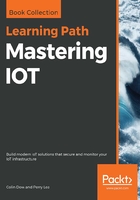
Sensor to controller
In many of the preceding examples for sensing components, the signal will require amplification, filtering, and calibration before going anywhere. Typically, the hardware will need an analog-to-digital converter of some resolution. The following is a simple 24-bit ADC that outputs a 5V signal:

The output can then be raw pulse-modulated data, or a serial interface such as I2C, SPI, or UART to a microcontroller or digital signal processor. A good example of this in a real system is the Texas Instruments infrared thermopile sensor (TMP007). This is a contactless MEMS temperature sensor that absorbs infrared wavelengths and converts them to a reference voltage while using a cold junction reference temperature. It is rated for accurately detecting temperatures in environments between -40 degrees Celsius to +125 degrees Celsius. We can see the components covered in this chapter for this part in the following figure:
